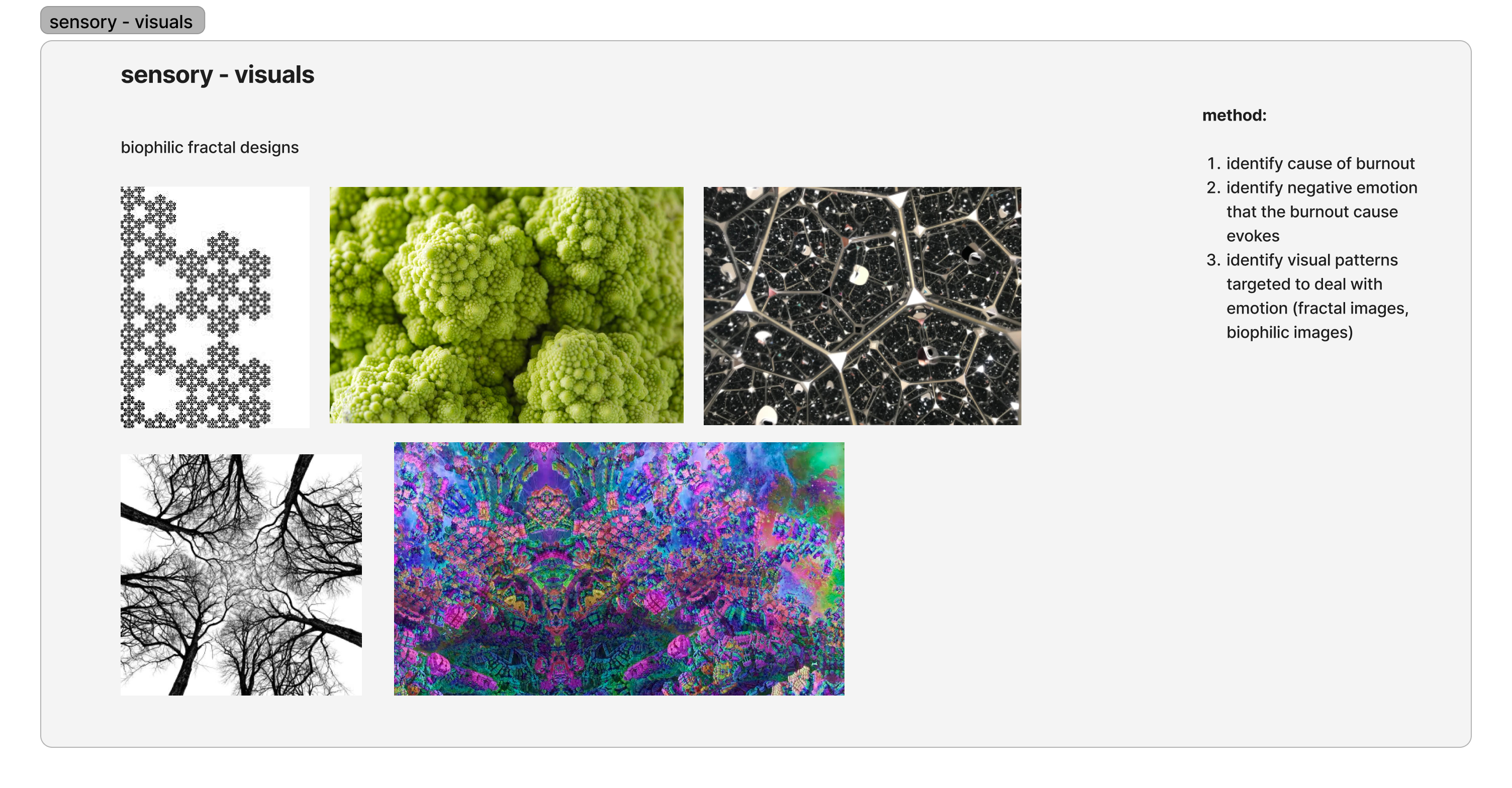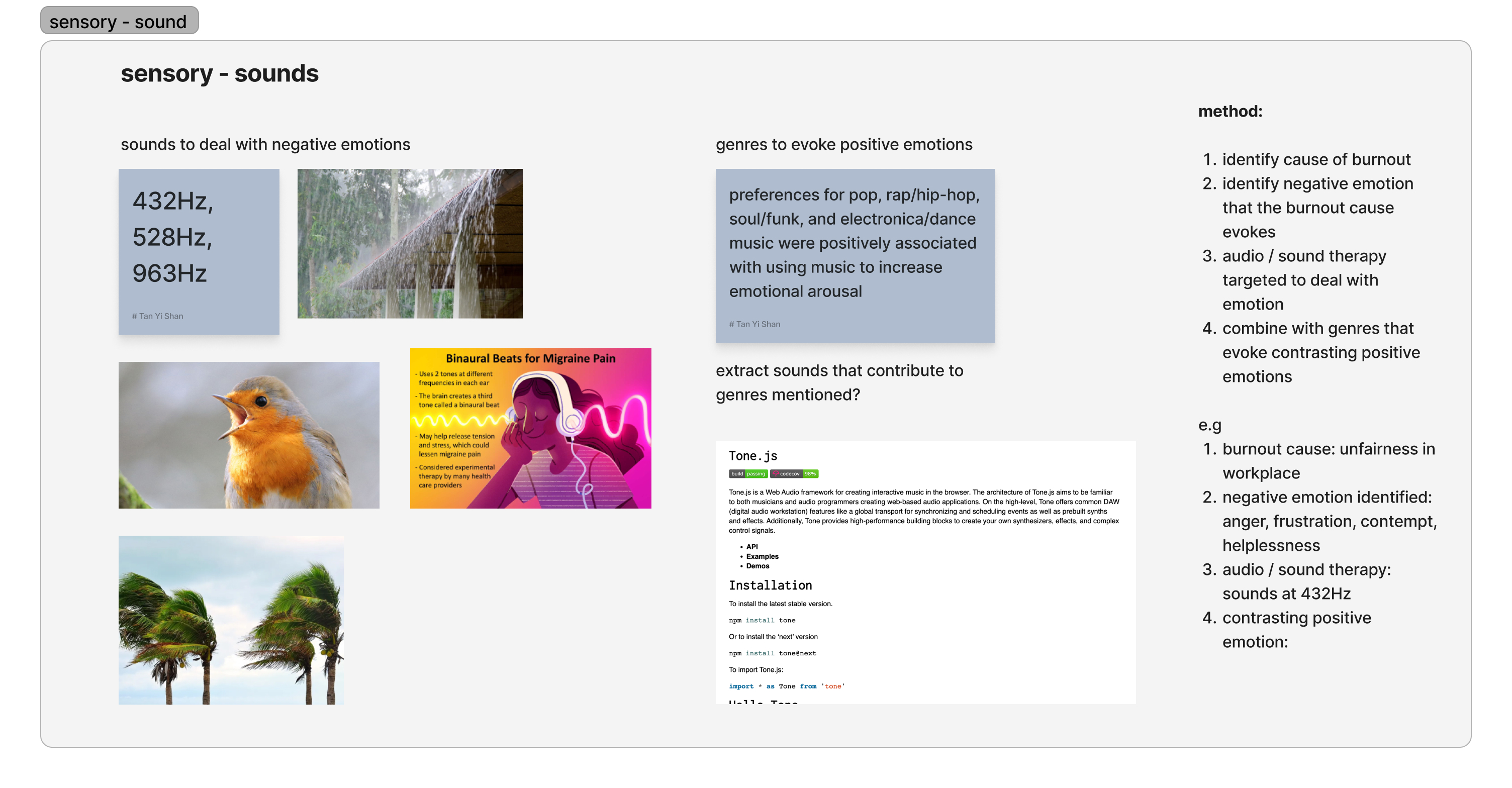week 12
visual and sound moodboards
descriptive
a subtitle change was necessary. my research is not centred around the harmful practices of
design practice any more. instead, i realised i’ve slowly started to focus on creating little
antidotes to make the practices we can’t change better using other devices. this one focuses on
using sensory experiences to make mindfulness exercises more effective.
i limited my research to visual and auditory experiences. both are broad enough subjects on
their own already, so i had to decide what type of visual and auditory aspects i wanted to focus
on.

visual moodboard research
the point of my project was to create a more engaging experience for users to practise
mindfulness exercises in. some things that came to mind was museum experiences, colour theory,
movements that helped an individual keep calm. there’s a term i’m researching called biophilic
fractal designs. it’s a type of design of which the forms resemble nature, and often used in
architecture.
“Biophilia—nature-loving—recognizes the inherent need of humans to connect with nature [3]. Around this time, pioneering psychology experiments by Roger Ulrich and colleagues showed that exposure to nature’s scenery induced positive changes in people, including significant stress reduction. This even accelerated the recovery of patients from major surgery [4–6].” (Taylor, 1)
to express this, i thought of using light projection, or kaleidoscopes. i wanted to create an
immersive
experience. fractals meant using rhythm and repetition in biophilic features. a popular
biophilic fractal is
the features of a romanesco broccoli. there are pinecones and succulents as well.
there are a few ways i can go about with biophilic fractal designs. should i generate my own
images? or
should i use what already exists in nature? i created moodboards on the possible outcomes i plan
to achieve.
all of these seem very hard to achieve : ) i feel like i’m shooting myself in the leg.
and then i started scrolling pinterest and searching up how other artists used lighting and
visuals to
induce positive feelings, wanting to avoid the honestly quite concrete research i already have.

sound moodboard research
auditory experiences wise, the most widely known sound used in mindfulness exercises is sounds at 432hz. it’s not scientifically proven, but musicians have found that 432hz is mathematically consistent with the universe. it’s known as verdi's 'a' – named after giuseppe verdi, a famous italian composer. i plan on reproducing this sound, while combining it with distinct sounds from certain music genres that help influence emotions.








analytical
i definitely overthink and overcomplicate things. but what to do. everything in the world is connected in one way or another and this theory will lead to something else. the deeper i read into things, the more i uncover and i feel like i have to read everything regarding this new theory to justify what i’m doing. i’ve decided to just go ahead with what i have for now. i’ll read a little more to link my topics together in my dissertation, but go ahead with these for my experiments and prototypes. perhaps i will discover new emotions and results after some user feedback.
reflective
as mentioned earlier, i did a few more readings so that my research could be linked together
better, and there was better justification behind what i’m going for. i found burnout stage
phase models very useful to reference, and i think it makes things easier for myself. i found it
easier to explain exactly which part of burnout i was combatting.
i did a lot of analysing and reflecting this week, to follow up with the comments from last
week’s presentation and with how to proceed on with my project. i keep feeling like my outcome
is far off from what i initially planned on achieving, so i drafted out my initial plans on
paper once again, and brainstormed from there. it made things a little bit clearer, and helped
me find out about biophilic fractals. i forgot what i had to search for to achieve this. i think
i was looking up mindfulness exercises that’s already available, and looking at the type of
visuals most of them had, to see if there were any readings and theories related to this. why
did they all use this certain type of imagery?
i have many concerns with this though. how many people will find this useful? how will i
evaluate the effectiveness of such an exercise? unfortunately, it’s quite impossible for me to
think in a step-by-step way. i like to take leaps!!!!! because i am very idealistic even though
realistically, i know i will end up having to give up some parts of my research in order to
present something by next year.
conclusion
go ahead with finding out how i can replicate fractal designs